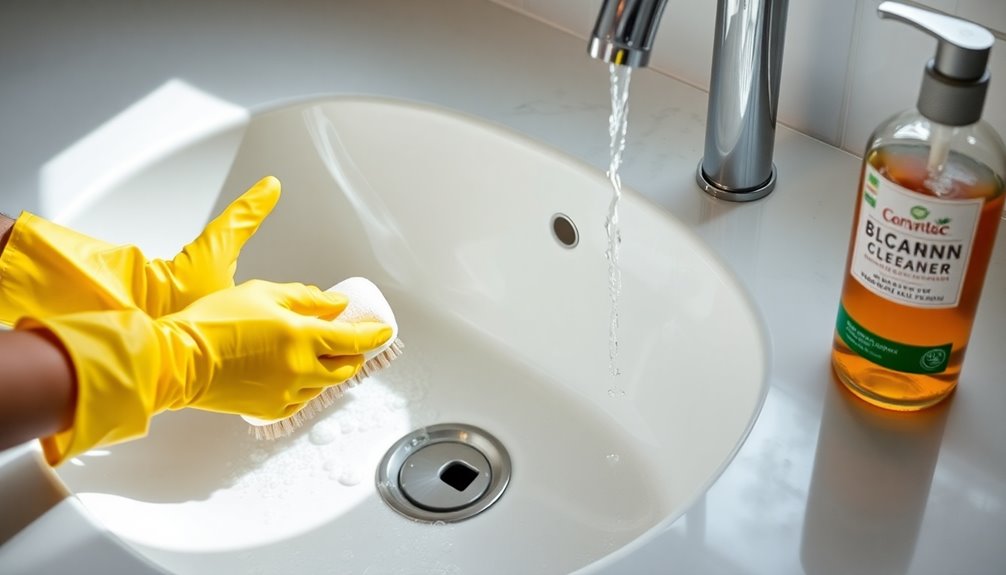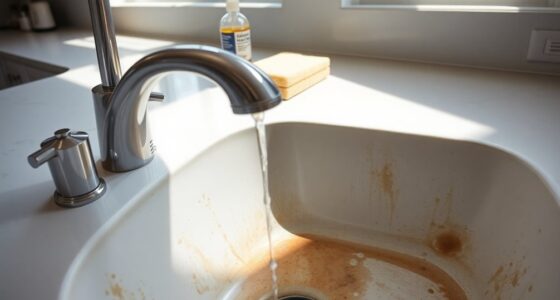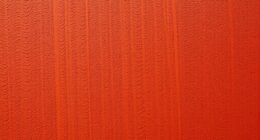To clean your composite sink, start with daily maintenance using mild dish soap and a non-abrasive sponge. Rinse it thoroughly to remove any soap residue and dry it with a soft cloth to avoid water spots. For stains, scrub gently with a baking soda and vinegar paste or a non-abrasive cleaner. To tackle hard water stains, use a vinegar-water solution and let it sit before scrubbing. There's more you can do to keep your sink spotless and shiny.
Key Takeaways
- Clean daily with mild dish soap and a non-abrasive sponge to maintain the sink's appearance.
- Rinse thoroughly after cleaning to eliminate food particles and soap residue.
- Apply a thin layer of mineral oil monthly for enhanced shine and protection.
- Use natural cleaners or gentle solutions to prevent damage, especially on colored surfaces.
- Avoid harsh chemicals and abrasive materials to prevent scratching and surface damage.
Routine Care & Maintenance
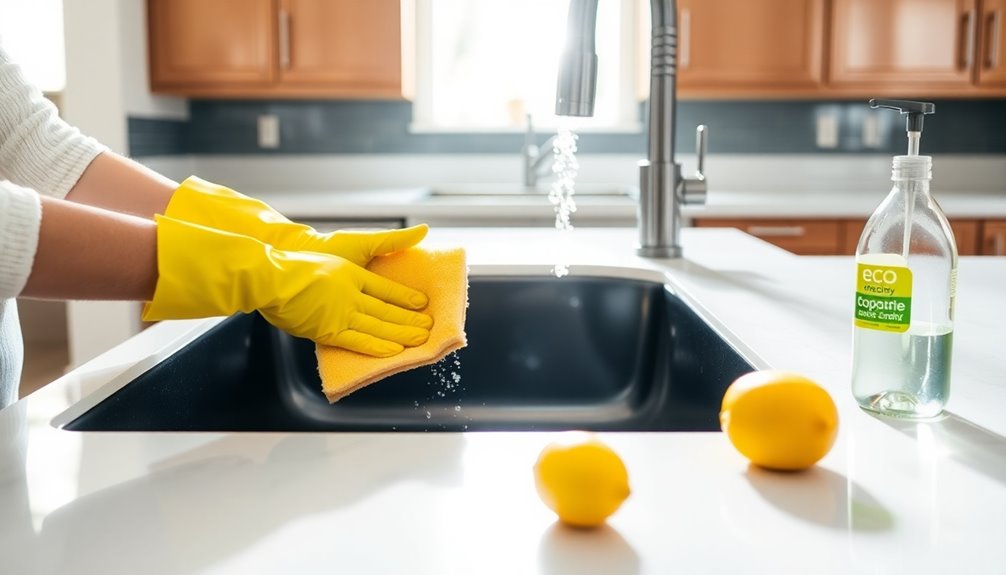
To keep your composite sink looking its best, you should clean it daily with mild dish soap and a non-abrasive sponge. This routine helps prevent buildup and maintain its appearance.
After cleaning, rinse thoroughly to eliminate food particles and soap residue that can lead to stubborn stains. To prevent water spots, dry the sink with a soft cloth.
Don't forget to perform a weekly scrub with your sponge and dish detergent to guarantee ongoing maintenance and shine retention.
Additionally, apply a thin layer of mineral oil monthly to enhance the sink's appearance and help prevent white spots from hard water.
Removing Stains & Scuff Marks
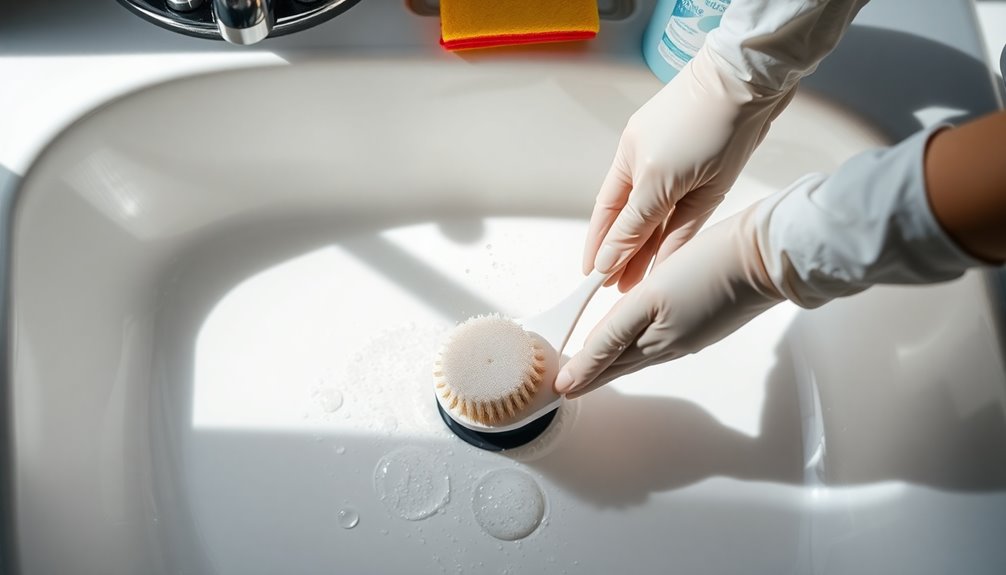
While composite sinks are durable and stylish, they can still accumulate stains and scuff marks over time.
To tackle these issues, mix baking soda with white vinegar to create a gentle paste. Apply it to the affected areas and scrub lightly with a soft cloth.
For stubborn stains, use a non-abrasive cleaner like Bar Keepers Friend or Soft Scrub. For light scuff marks, a soft scouring pad with mild dish soap will do the trick without scratching the surface.
Remember to rinse thoroughly after cleaning and dry the sink to maintain its appearance.
If deeper cleaning is needed, consider a mix of oxygen bleach and hot water, letting it sit for a couple of hours before rinsing.
Tackling Hard Water Stains and Mineral Deposits
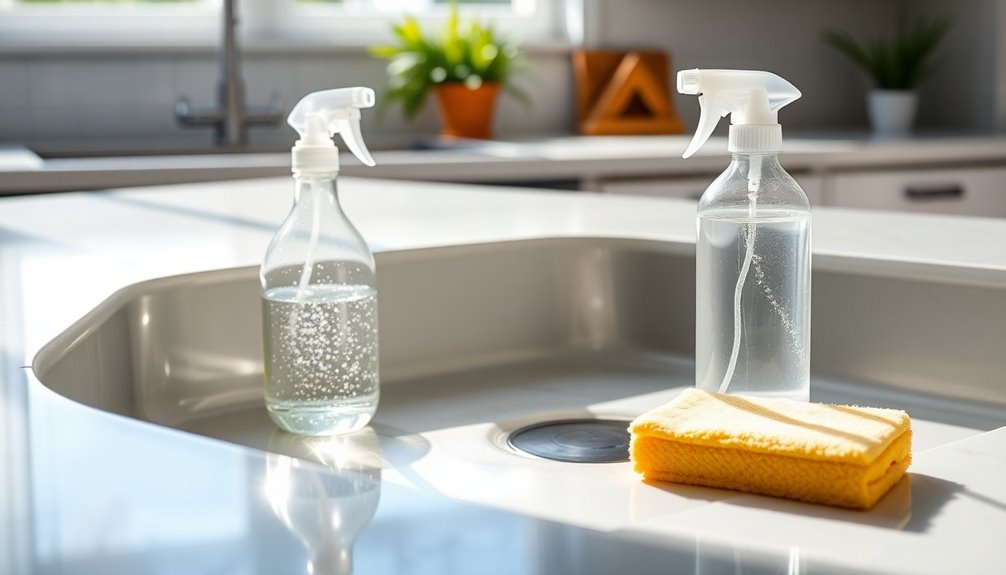
Hard water stains and mineral deposits can quickly detract from the beauty of your composite sink, but tackling them doesn't have to be a chore.
Start by mixing equal parts white vinegar and water in a spray bottle. Apply it to the affected areas and let it sit for 15-30 minutes to break down the buildup. Then, gently scrub with a damp cloth or sponge and rinse thoroughly with warm water.
To keep your sink looking great, remember to:
- Soak stubborn stains in vinegar for 30 minutes.
- Apply a thin layer of mineral oil to prevent future deposits.
- Dry the sink with a soft cloth to avoid water spots and maintain its shine.
Special Care for Black or White Composite Sinks
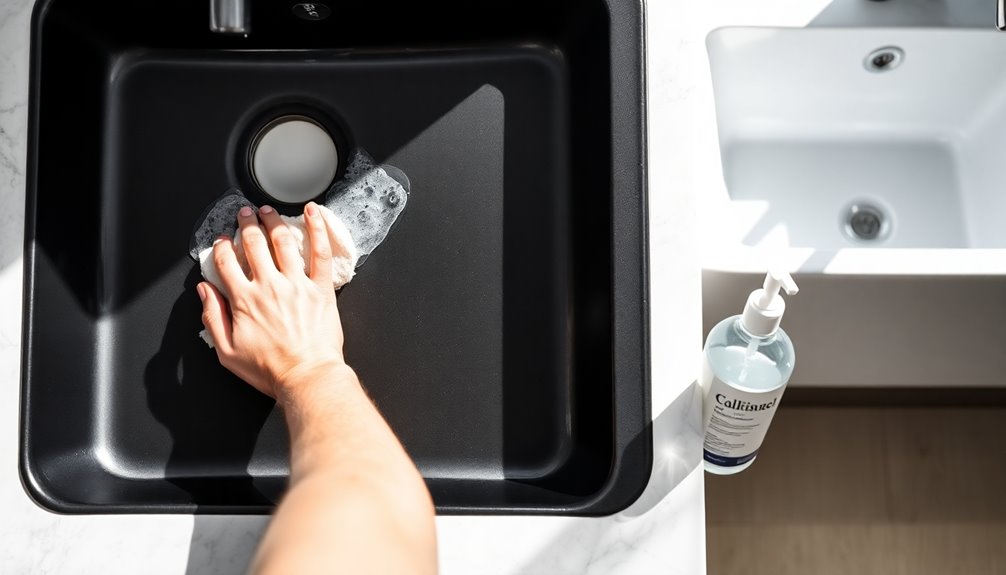
Maintaining the beauty of your composite sink goes beyond just tackling hard water stains and mineral deposits.
For a black composite sink, daily cleaning with a non-abrasive cleaner is essential to combat hard water stains and soap scum.
On the other hand, if you have a white composite sink, be quick to clean up spills from dark liquids to prevent permanent staining.
Always use natural cleaning solutions or gentle cleaners specifically for composite materials to avoid damaging the surface.
Remember to utilize a soft cloth when drying to maintain shine and prevent scratching, especially on lighter surfaces.
Finally, always rinse thoroughly after cleaning to keep your sink looking its best.
Regular daily cleaning is key!
Important Care Notes
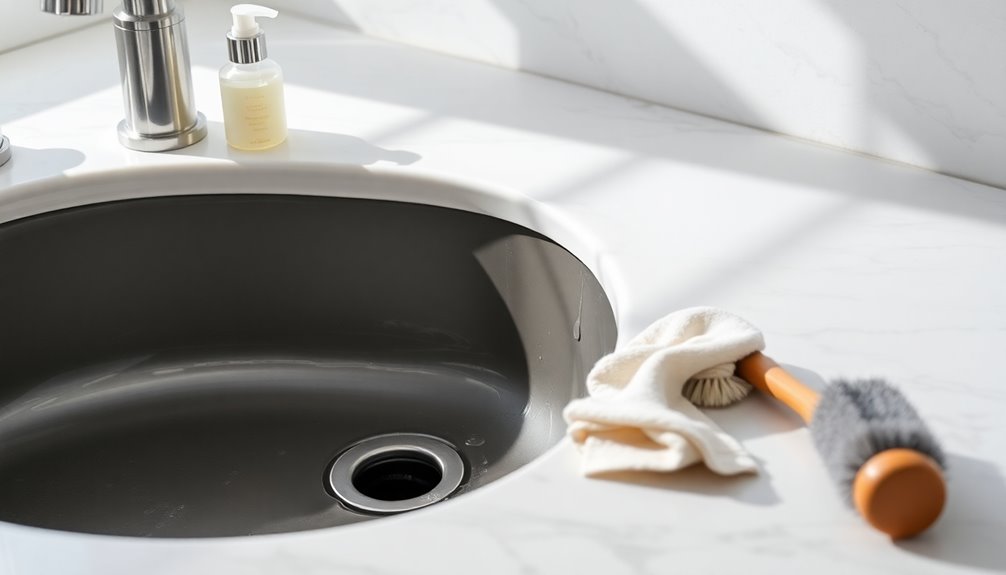
To keep your composite sink in top shape, it's vital to avoid harsh chemicals and abrasive materials that can lead to damage. Remember, composite sinks are made to last, but proper care is important.
Here are some significant care notes:
- Avoid using full-strength bleach or cleaners with ammonia, as they can harm the surface.
- Don't use abrasive tools like steel wool, which can scratch and reduce aesthetic appeal.
- Use a soft cloth to avoid water stains and stubborn spots during regular daily cleaning.
For deep cleaning, steer clear of chemical drain openers and avoid cleaning paint or grout materials in the sink.
Frequently Asked Questions
What Is the Best Thing to Clean a Composite Sink With?
When you're looking for the best way to clean a composite sink, stick with mild dish soap and a non-abrasive sponge.
They'll effectively remove dirt without scratching the surface. For stubborn stains, try Bar Keepers Friend or Cif cleaning cream.
If limescale's an issue, mix equal parts water and white vinegar, but rinse well afterward.
For light stains, a paste of baking soda and water works wonders.
Just avoid harsh chemicals or abrasive scrubbers!
How Do You Make a Composite Sink Look New Again?
Did you know that a well-maintained sink can last up to 15 years longer than a neglected one?
To make your composite sink look new again, start by cleaning it with a mild dish soap and warm water solution.
For stubborn stains, use a baking soda paste.
Apply a 50% vinegar solution for hard water stains, and finish with a monthly application of mineral oil to restore shine and protect against future damage.
Can I Use a Magic Eraser on a Composite Sink?
Yes, you can use a Magic Eraser on a composite sink, but you've gotta be careful.
Always test it on a small, hidden area first to make sure it doesn't scratch the surface. If you decide to use it, dampen the eraser and apply gentle pressure.
Remember, don't make it a regular habit, as it can wear down the finish over time.
After cleaning, rinse and dry the sink thoroughly to keep it looking great.
Can I Use Bar Keepers Friend on Composite Sink?
You might worry about using Bar Keepers Friend on your composite sink, but it's actually safe when applied correctly.
Just remember to use it sparingly and follow the manufacturer's instructions. Apply it with a soft cloth or non-abrasive sponge, and always rinse thoroughly afterward.
It's wise to do a spot test in an inconspicuous area first. This way, you can tackle those tough stains without risking damage to your sink's finish.
Conclusion
In short, keeping your composite sink in top shape isn't rocket science. With regular care, you can easily tackle stains and hard water deposits. Just remember, a little effort goes a long way, and soon enough, your sink will shine like new. So, roll up your sleeves and immerse yourself in the cleaning process—your kitchen will thank you! With these tips, you'll have your sink looking spick and span in no time.
